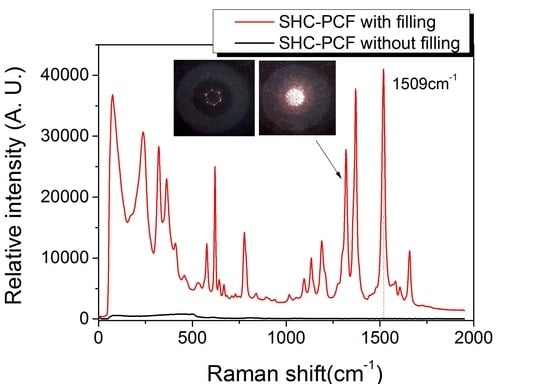A Simplified Hollow-Core Photonic Crystal Fiber SERS Probe with a Fully Filled Photoreduction Silver Nanoprism
Abstract
:1. Introduction
2. Principle of the SERS Fiber Probe
3. Prepartion of AgPRs and Experimental Setup
4. Experiment Results and Discussions
5. Conclusions
Author Contributions
Funding
Conflicts of Interest
References
- Chen, Z.Y.; Dai, Z.M.; Chen, N.; Liu, S.P.; Pang, F.F.; Lu, B.; Wang, T.Y. Gold Nanoparticles-Modified Tapered Fiber Nanoprobe for Remote SERS Detection. IEEE Photonics Technol. Lett. 2014, 26, 777–780. [Google Scholar] [CrossRef]
- Zhang, J.; Chen, S.M.; Gong, T.C.; Zhang, X.L.; Zhu, Y. Tapered Fiber Probe Modified by Ag Nanoparticles for SERS Detection. Plasmonics 2016, 11, 743–751. [Google Scholar] [CrossRef]
- Cao, J.; Zhao, D.; Mao, Q.H. Laser-induced synthesis of Ag nanoparticles on the silanized surface of a fiber taper and applications as a SERS probe. RSC Adv. 2015, 5, 99491–99497. [Google Scholar] [CrossRef]
- Shi, C.; Lu, C.; Gu, C.; Tian, L.; Newhouse, R.; Chen, S.W. Inner wall coated hollow core waveguide sensor based on double substrate surface enhanced Raman scattering. Appl. Phys. Lett. 2008, 93, 153101. [Google Scholar] [CrossRef]
- Zhang, Z.; Xiao, R.; Yang, T.X.; Bo, X.C.; Wang, S.Q. Liquid core capillary-based Raman probe for surface-enhanced Raman scattering detection. Laser Phys. Lett. 2014, 11, 035603. [Google Scholar] [CrossRef]
- Zhang, Y.; Gu, C.; Schwartzberg, A.M.; Zhang, J.Z. Surface-enhanced Raman scattering sensor based on D-shaped fiber. Appl. Phys. Lett. 2005, 87, 123105. [Google Scholar] [CrossRef]
- Oo, M.K.K.; Han, Y.; Martini, R.; Sukhishvili, S.; Du, H. Forward-propagating surface-enhanced Raman scattering and intensity distribution in photonic crystal fiber with immobilized Ag nanoparticles. Opt. Lett. 2009, 34, 968–970. [Google Scholar] [CrossRef] [PubMed]
- Khetani, A.; Momenpour, A.; Alarcon, E.I.; Anis, H. Hollow core photonic crystal fiber for monitoring leukemia cells using surface enhanced Raman scattering (SERS). Biomed. Opt. Express 2015, 6, 4599–4609. [Google Scholar] [CrossRef] [PubMed]
- Zhang, N.; Humbert, G.; Gong, T.X.; Shum, P.P.; Li, K.W.; Auguste, J.L.; Wu, Z.F.; Hu, D.J.J.; Luan, F.; Dinh, Q.X.; et al. Side-channel photonic crystal fiber for surface enhanced Raman scattering sensing. Sens. Actuator B Chem. 2015, 223, 195–201. [Google Scholar] [CrossRef]
- Yang, X.; Shi, C.; Wheeler, D.; Newhouse, R.; Chen, B.; Zhang, J.Z.; Gu, C. High-sensitivity molecular sensing using hollow-core photonic crystal fiber and surface-enhanced Raman scattering. J. Opt. Soc. Am. A Opt. Image Sci. Vis. 2010, 27, 977–984. [Google Scholar] [CrossRef] [PubMed]
- Gerome, F.; Jamier, R.; Auguste, J.L.; Humbert, G.; Blondy, J.M. Simplified hollow-core photonic crystal fiber. Opt. Lett. 2010, 35, 1157–1159. [Google Scholar] [CrossRef] [PubMed]
- Litchinitser, N.M.; Abeeluck, A.K.; Headley, C.; Eggleton, B.J. Antiresonant reflecting photonic crystal optical waveguides. Opt. Lett. 2002, 27, 1592–1594. [Google Scholar] [CrossRef] [PubMed]
- Hu, D.J.J.; Wang, Y.X.; Lim, J.L.; Zhang, T.S.; Milenko, K.B.; Chen, Z.H.; Jiang, M.; Wang, G.H.; Luan, F.; Shum, P.P.; et al. Novel miniaturized Fabry–Perot refractometer based on a simplified hollow-core fiber with a hollow silica sphere tip. IEEE Sens. J. 2012, 12, 1239–1245. [Google Scholar] [CrossRef]
- Wang, Y.; Wang, D.N.; Liao, C.R.; Hu, T.Y.; Guo, J.T.; Wei, H.F. Temperature-insensitive refractive index sensing by use of micro Fabry–Perot cavity based on simplified hollow-core photonic crystal fiber. Opt. Lett. 2013, 38, 269–271. [Google Scholar] [CrossRef] [PubMed]
- Wu, Z.F.; Wang, Z.; Liu, Y.G.; Han, T.T.; Li, S.; Wei, H.F. Mechanism and characteristics of long period fiber gratings in simplified hollow-core photonic crystal fibers. Opt. Express 2011, 19, 17344–17349. [Google Scholar] [CrossRef] [PubMed]
- Liu, S.H.; Liu, N.L.; Hou, M.X.; Guo, J.T.; Li, Z.H.; Lu, P.X. Direction-independent fiber inclinometer based on simplified hollow core photonic crystal fiber. Opt. Lett. 2013, 38, 449–451. [Google Scholar] [CrossRef] [PubMed]
- Jin, L.; Guan, B.O.; Wei, H.F. Sensitivity characteristics of Fabry–Perot pressure sensors based on hollow-core microstructured fibers. J. Lightwave Technol. 2013, 31, 2526–2532. [Google Scholar] [CrossRef]
- Yu, Y.Q.; Chen, X.; Huang, Q.D.; Du, C.L.; Ruan, S.C.; Wei, H.F. Enhancing the pressure sensitivity of a Fabry-Perot interferometer using a simplified hollow-corephotonic crystal fiber with a microchannel. Appl. Phys. B 2015, 120, 461–467. [Google Scholar] [CrossRef]
- Wu, J.; Yin, X.J.; Wang, W.Y.; Hong, X.M.; Du, Y.; Geng, Y.F.; Li, X.J. All-fiber reflecting temperature probe based on the simplified hollow-core photonic crystal fiber filled with aqueous quantum dot solution. Appl. Opt. 2016, 55, 974–978. [Google Scholar] [CrossRef] [PubMed]
- Tang, B.; Xu, S.; An, J.; Zhao, B.; Xu, W. Photoinduced Shape Conversion and Reconstruction of Silver Nanoprisms. Langmuir 2009, 113, 7025–7030. [Google Scholar] [CrossRef]
- Xue, C.; Mirkin, C.A. pH-Switchable silver nanoprism growth pathways. Angew. Chem. Int. Ed. 2007, 46, 2036–2038. [Google Scholar] [CrossRef] [PubMed]






© 2018 by the authors. Submitted for possible open access publication under the terms and conditions of the Creative Commons Attribution (CC BY) license (http://creativecommons.org/licenses/by/4.0/).
Share and Cite
Geng, Y.; Xu, Y.; Tan, X.; Wang, L.; Li, X.; Du, Y.; Hong, X. A Simplified Hollow-Core Photonic Crystal Fiber SERS Probe with a Fully Filled Photoreduction Silver Nanoprism. Sensors 2018, 18, 1726. https://doi.org/10.3390/s18061726
Geng Y, Xu Y, Tan X, Wang L, Li X, Du Y, Hong X. A Simplified Hollow-Core Photonic Crystal Fiber SERS Probe with a Fully Filled Photoreduction Silver Nanoprism. Sensors. 2018; 18(6):1726. https://doi.org/10.3390/s18061726
Chicago/Turabian StyleGeng, Youfu, Yiwen Xu, Xiaoling Tan, Lina Wang, Xuejin Li, Yu Du, and Xueming Hong. 2018. "A Simplified Hollow-Core Photonic Crystal Fiber SERS Probe with a Fully Filled Photoreduction Silver Nanoprism" Sensors 18, no. 6: 1726. https://doi.org/10.3390/s18061726





